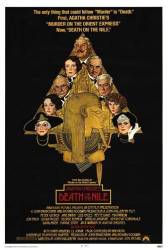Factual error: After Linnet Ridgeway had almost been crushed by a stone falling down from the temple of Karnak, Dr. Bessner advised her to go back to the boat to have a rest. She replied that it can be for just a couple of hours, as she must see the temple of Abu Simbel in the evening. In the next scene, she is really visiting Abu Simbel together with Simon and in the late evening they are back on the Nile steamer. This is absolutely impossible, as the distance between the temple of Karnak and the temple of Abu Simbel is about 400km (250 miles). By that time, it would have been impossible to manage 800km (500 miles) within one afternoon just for a visiting tour. And it is not very logical, as the Nile steamer was going up the Nile to Wadi Halfa, so they would have passed Abu Simbel anyway later during their trip. (00:47:00)
Factual error: In the Abu Simbel scene, watch closely when they show a side-view shot of Jackie, accidentally depicting the shores of Lake Nasser in the background. This reservoir was built only in the 1960s and didn't exist at the time the movie is set in (1930s). (In fact, the whole temple had to be cut from the rock and moved to higher ground following the completion of the Aswan Dam, so the "original location" was no more available for the film crew.) (00:51:15)
Factual error: The body of Louise (the maid) is discovered when the room-service guy drops a towel on the floor and it lands in a pool of blood. The blood obviously ran out of her cabin from under the closed door. However, the cabin door thresholds are not at level with the floor (neither outside nor inside the cabins), but several inch higher, so her blood could not possibly have escaped through the cabin door. All along the movie you can see the actors carefully stepping over those irritating thresholds in order not to stumble, though I think it is hard to spot the edge from within Louise's cabin. But watch when Dr Bessner enters her cabin to investigate the body, it's pretty obvious he takes a step "down". (01:45:15)
Suggested correction: You're right, there are big thresholds. But I have just watched this film again, and when Poirot and Race enter her room after she is discovered, you can see vents in the threshold, which would explain how the blood seeped out onto the deck. I do think they were put into the film set for the room interior shot on purpose to explain how the blood seeped out, as I cannot see any vents when glimpsing the thresholds on the deck side.
Factual error: Mrs. Van Schuyler reads the news of the Linnet's wedding on a copy of the Washington Post bearing the date September 11 1930. However, the cars used in the movie (Linnet's Rolls-Royce 25/30 and Jackie's MG J2 Midget) are from several years later in the decade. (00:09:30)
Factual error: When Jackie pulls out the unusually high amount of cash that Simon happened to have on him, you can read the banknote was issued in 1940. The movie is set in the 1930s. (02:08:40)
Suggested correction: 1) The shot is onscreen for a fraction of a second. 2) Even using freeze-frame, I do not see any visible date. Do you have a screen capture of this?
I did not, but I took one for you.;). I just uploaded a zoomed-in and straightened version you prolly can already see in the pending screenshots section. It says "Juin 1940", but you shouldn't need it; the note is on screen for a full second or slightly less, but the fact that allows you to read it without even pausing is that she holds the note straight, her motion stops just long enough to avoid stealing the moment with freeze-frame (in fact if you take screenshots on VLC like I do, the compression might make it harder to read than watching it in real time). And also pre-WW2 1000 Franc notes have a huge date, I circled it for you in the screenshot. You can also notice the signature of the "caissier general" that matches notes post-summer of 1937 at earliest, and the only date given in the movie is 1930. Serial numbers are consistent with a 1940 release as well, they definitely used a legit banknote from the era who happened to be a late print.





